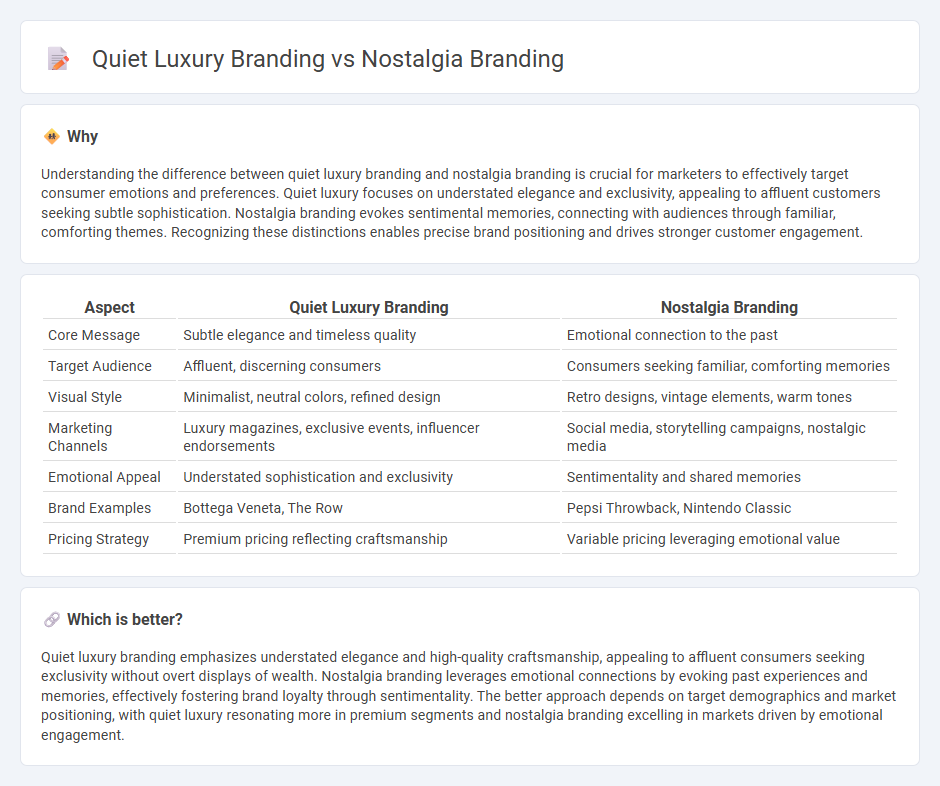
Quiet luxury branding emphasizes understated elegance, timeless quality, and subtlety, appealing to discerning consumers who value exclusivity without ostentation. Nostalgia branding leverages emotional connections by evoking sentimental memories and cultural heritage, resonating strongly with audiences seeking familiarity and comfort. Explore the unique strategies behind these contrasting approaches to elevate your marketing impact.
Why it is important
Understanding the difference between quiet luxury branding and nostalgia branding is crucial for marketers to effectively target consumer emotions and preferences. Quiet luxury focuses on understated elegance and exclusivity, appealing to affluent customers seeking subtle sophistication. Nostalgia branding evokes sentimental memories, connecting with audiences through familiar, comforting themes. Recognizing these distinctions enables precise brand positioning and drives stronger customer engagement.
Comparison Table
| Aspect | Quiet Luxury Branding | Nostalgia Branding |
|---|---|---|
| Core Message | Subtle elegance and timeless quality | Emotional connection to the past |
| Target Audience | Affluent, discerning consumers | Consumers seeking familiar, comforting memories |
| Visual Style | Minimalist, neutral colors, refined design | Retro designs, vintage elements, warm tones |
| Marketing Channels | Luxury magazines, exclusive events, influencer endorsements | Social media, storytelling campaigns, nostalgic media |
| Emotional Appeal | Understated sophistication and exclusivity | Sentimentality and shared memories |
| Brand Examples | Bottega Veneta, The Row | Pepsi Throwback, Nintendo Classic |
| Pricing Strategy | Premium pricing reflecting craftsmanship | Variable pricing leveraging emotional value |
Which is better?
Quiet luxury branding emphasizes understated elegance and high-quality craftsmanship, appealing to affluent consumers seeking exclusivity without overt displays of wealth. Nostalgia branding leverages emotional connections by evoking past experiences and memories, effectively fostering brand loyalty through sentimentality. The better approach depends on target demographics and market positioning, with quiet luxury resonating more in premium segments and nostalgia branding excelling in markets driven by emotional engagement.
Connection
Quiet luxury branding and nostalgia branding are connected through their shared emphasis on emotional resonance and timeless appeal that fosters deep consumer loyalty. Both strategies leverage understated elegance and historical references to evoke a sense of authenticity and enduring quality, appealing to consumers' desires for meaningful and lasting value. By intertwining subtle sophistication with nostalgic storytelling, brands create powerful connections that transcend fleeting trends and cultivate long-term brand equity.
Key Terms
**Nostalgia Branding:**
Nostalgia branding leverages emotional connections by evoking memories and familiar cultural references from the past, creating a sense of comfort and trust among consumers. It often incorporates retro design elements, vintage packaging, and storytelling that taps into the consumer's personal or collective history, enhancing brand loyalty and emotional engagement. Discover how nostalgia branding can deepen customer relationships and boost brand resonance in competitive markets.
Retro Appeal
Nostalgia branding leverages retro appeal by evoking sentimental memories and cultural touchstones from past decades, often using vintage design elements and storytelling that resonate emotionally with consumers. Quiet luxury branding, while also valuing heritage, emphasizes understated elegance and timeless quality, focusing on subtle and refined retro influences rather than overt nostalgia. Explore how these distinct approaches shape brand identity and consumer connections in the evolving luxury market.
Emotional Connection
Nostalgia branding leverages memories and sentimental feelings from the past to create deep emotional bonds, tapping into consumers' longing for familiarity and comfort. Quiet luxury branding emphasizes understated elegance and timeless quality, fostering an emotional connection through subtlety and exclusivity rather than overt displays of wealth. Explore how these distinct branding strategies impact consumer loyalty and market positioning by learning more about their emotional dynamics.
Source and External Links
Nostalgia Marketing: How Brands Are Winning With Retro - Nostalgia branding connects products with happy memories using vintage designs, throwback campaigns, pop culture references, and influencer collaborations to create emotional bonds and boost customer appeal.
Nostalgia Marketing: How Past Trends Can Drive Future Growth - Brands use nostalgia by reviving retro products and packaging, leveraging iconic cultural references, and storytelling to engage both loyal and new customers, exemplified by Nintendo's NES Classic Edition.
Why Gen Z loves nostalgia marketing - Successful nostalgia branding for Gen Z demands authenticity and blends retro elements with modern relevance, as seen in examples like Pepsi's Crystal Pepsi revival and Y2K-themed fashion campaigns by Diesel and Balenciaga.
 dowidth.com
dowidth.com